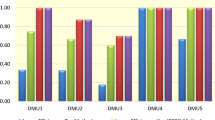Abstract
This paper is concerned with the use of imprecise data in data envelopment analysis (DEA). Imprecise data means that some data are known only to the extent that the true values lie within prescribed bounds while other data are known only in terms of ordinal relations. Imprecise data envelopment analysis (IDEA) has been developed to measure the relative efficiency of decision-making units (DMUs) whose input and/or output data are imprecise. In this paper, we show two distinct strategies to arrive at an upper and lower bound of efficiency that the evaluated DMU can have within the given imprecise data. The optimistic strategy pursues the best score among various possible scores of efficiency and the conservative strategy seeks the worst score. In doing so, we do not limit our attention to the treatment of special forms of imprecise data only, as done in some of the studies associated with IDEA. We target how to deal with imprecise data in a more general form and, under this circumstance, we make it possible to grasp an upper and lower bound of efficiency. The generalized method we develop in this paper also gives rise to a new scheme of efficiency classifications that is more detailed and informative than the standard efficient and inefficient partition.
Similar content being viewed by others
References
Arnold V, Bardhan I, Cooper WW and Gallegos A (1998). Primal and dual optimality in computer codes using two-stage solution procedures in DEA. In: Aranson J and Zionts S (eds). Operations Research: Methods, Models and Applications. Quorum Books, Westport, CT, pp 57–96.
Belton V and Vickers SP (1993). Demystifying DEA—a visual interactive approach based on multiple criteria analysis. J Opl Res Soc 44: 883–896.
Bouyssou D (1999). Using DEA as a tool for MCDM: some remarks. J Opl Res Soc 50: 974–978.
Charnes A and Cooper WW (1962). Programming with linear fractional functionals. Naval Res Logistics Quarterly 9: 181–186.
Cook WD, Kress M and Seiford LM (1993). On the use of ordinal data in data envelopment analysis. J Opl Res Soc 44: 133–140.
Cook WD, Kress M and Seiford LM (1996). Data envelopment analysis in the presence of both quantitative and qualitative factors. J Opl Res Soc 47: 945–953.
Cooper WW, Park KS and Pastor JT (1999a). RAM: a range adjusted measure of inefficiency for use with additive models, and relations to other models and measures in DEA. J Prod Anal 11: 5–42.
Cooper WW, Park KS and Yu G (1999b). IDEA and AR-IDEA: models for dealing with imprecise data in DEA. Mngt Sci 45: 597–607.
Cooper WW, Park KS and Yu G (2001a). An illustrative application of IDEA (imprecise data envelopment analysis) to a Korean mobile telecommunication company. Opns Res 49: 807–820.
Cooper WW, Park KS and Yu G (2001b). IDEA (imprecise data envelopment analysis) with CMDs (column maximum decision making units). J Opl Res Soc 52: 176–181.
Dantzig GB (1963). Linear Programming and Extensions. Princeton University Press: New Jersey.
Despotis DK and Smirlis YG (2002). Data envelopment analysis with imprecise data. Eur J Opl Res 140: 24–36.
Kao C and Liu ST (2000a). Fuzzy efficiency measures in data envelopment analysis. Fuzzy Sets Systems 113: 427–437.
Kao C and Liu ST (2000b). Data envelopment analysis with missing data: an application to university libraries in Taiwan. J Opl Res Soc 51: 897–905.
Kim SH, Park CK and Park KS (1999). An application of data envelopment analysis in telephone offices evaluation with partial data. Comput Opns Res 26: 59–72.
Park KS (2004). Simplification of the transformations and redundancy of assurance regions in IDEA (imprecise DEA). J Opl Res Soc 55: 1363–1366.
Park KS (2005). Duality and efficiency characterizations in DEA with imprecise data. Working paper (unpublished), Korea University, Seoul, Korea.
Park KS and Kim SH (1997). Tools for interactive multiattribute decisionmaking with incompletely identified information. Eur J Opl Res 98: 111–123.
Sage AP and White CC (1984). ARIADNE: A knowledge-based interactive system for planning and decision support. IEEE Systems Man Cybernet 14: 35–47.
Soyster AL (1973). Convex programming with set-inclusive constraints and applications to inexact linear programming. Opns Res 21: 1154–1157.
Soyster AL (1979). Inexact linear programming with generalized resource sets. Eur J Opl Res 3: 316–321.
Stewart TJ (1996). Relationships between data envelopment analysis and multi-criteria decision analysis. J Opl Res Soc 47: 654–665.
Zhu J (2003). Imprecise data envelopment analysis (IDEA): A review and improvement with an application. Eur J Opl Res 144: 513–529.
Zhu J (2004). Imprecise DEA via standard linear DEA models with a revisit to a Korean mobile telecommunication company. Opns Res 52: 323–329.
Acknowledgements
I thank the Editor and an anonymous referee for helpful comments and suggestions. I am also grateful for financial support from the Korean Research Foundation, Grant No. KRF-01-041-C00312, and from a Korea University Grant.
Author information
Authors and Affiliations
Corresponding author
Rights and permissions
About this article
Cite this article
Park, K. Efficiency bounds and efficiency classifications in DEA with imprecise data. J Oper Res Soc 58, 533–540 (2007). https://doi.org/10.1057/palgrave.jors.2602178
Received:
Accepted:
Published:
Issue Date:
DOI: https://doi.org/10.1057/palgrave.jors.2602178




